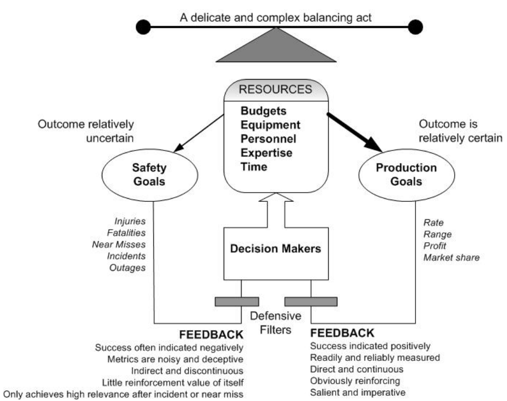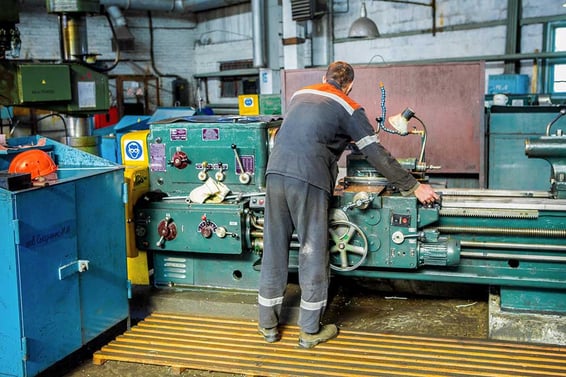Health is a State of Continuous Improvement
In our recent study "State of Safety Management 2020: 10 Safety Challenges You Need To Know", almost 70% of EHS managers said that they recognize involving their team in continuous safety improvements. The trouble is, the quest to increase safety performance can truly seem like a Holy Grail to EHS leaders — the ultimate reward that nobody has managed to gain.
But this shouldn't stop you from striving for it, should it?
Reducing injuries and incidents is crucial for the people because it builds feelings of safety and trust in the company. It's also critical for the business because it helps improve quality and reduce costs. But improving safety in the workplace needs to be an ongoing commitment. There is no other way.
"No matter how good you get you can always get better, and that's the exciting part."
—Tiger Woods ⛳️
What is continuous safety improvement?
It's the commitment to constantly analyze your safety performance through fact-based data, to address root causes and system weaknesses as soon as they are identified, and to experiment with changes that will lead to long-term systems improvement.
Sounds great in theory. But, as with all things in life, there are things that can stand in the way of promoting a safer working culture.
The challenges
If you want to make safety improvement a habit, start by identifying your roadblocks. What is preventing you from achieving continuous improvement?
Here are the most common health and safety challenges to look out for:
#1 Too much admin work
Our recent survey of EHS managers found that 66% find their job to involve a lot of paperwork, while 55% were frustrated by the amount of manual data entry their safety processes involve. Some methods and processes can indeed be time-consuming, and employees can find it frustrating to have these processes added to their day-to-day responsibilities. Safety becomes an administrative burden for both safety staff and front-line workers and, so, it can often be neglected. Eliminating paperwork can help you find the time you need to continuously improve your safety strategy.
#2 Lack of executive support
Ongoing safety improvements require ongoing financial support. And, when the budget comes into play, it may be difficult to get company leaders on board with safety initiatives. The problem is that the effect of new safety measures and procedures can only be seen in the long term. The benefits are not as tangible as those that come from investing in better production equipment. And, consequently, the ROI isn't as easy to calculate. That's why many safety initiative remain on the backburner.
Besides, as Dan Clark from SafetyBrief points out, "owners and managers—the bosses—don't often like change." It's no wonder because resistance to change is common human behaviour.
To tackle the lack of executive buy-in, he suggests to "start with no budget, in a small area to prove it and catch their attention."
You can listen to Mr. Clark's thoughts on continuous safety management in the short audio clip here.
#3 Worker mindset
It's not easy to get everyone on board with a new system and there are a few different mindsets you might recognize in colleagues which are detrimental to a dynamic safety strategy, such as:
- Apathy – Some staff members may be fully on-board to begin with, but they may lose interest after a while, causing the strategy to gradually lose effectiveness.
- Misunderstanding – A safety strategy must be very clear in its aims and objectives, to avoid individuals misinterpreting their responsibilities. The most dangerous misunderstanding which may occur here is employees thinking they need to underreport or hide incidents to ensure the success of the safety strategy.
- "It's someone else's job" – Workplace safety is the responsibility of every person in the organization, and a thorough safety strategy should encourage every individual to take that responsibility seriously. In a workplace culture where everybody assumes that someone else is handling the responsibility, there is a risk that nobody will engage at all and the system will fail from the start.
#4 Overcomplication
If staff feel overwhelmed with the number of rules, regulations, and processes they are following, they may be more likely to accidentally forget them, and cause more problems for the company. It's important to keep processes simple and make sure the strategy can be followed by staff members at all levels. This will include regular refreshers, clear reminders posted in necessary areas, as well as encouraging staff to teach one another and work together to make sure all responsibilities are fulfilled.
#5 New staff onboarding
Long-term employees will have absorbed the safety do's and don'ts as part of their everyday responsibilities. However, for new staff, trying to learn the ropes of a new role can be overwhelming. Especially, when paired with a safety process that is constantly changing.
That's not to suggest that learning the ins and outs of your safety plan and getting them involved in continuous safety improvement shouldn't be a priority. The company policies, procedures, and expectations for new starters should be introduced before they begin working. But the pace of change in your safety strategy should be carefully calculated so that people can adapt.
This list could go on and on. The challenges facing companies, the areas seeing the most issues and the level of employee engagement differ from industry to industry, and from company to company. Thankfully, it's also possible to overcome those barriers once identified, and get everyone on board, working towards improved safety in the workplace.
 Figure 1. Overview Illustrating the Complexity of the Decision Making Process. (adapted from Reason
Figure 1. Overview Illustrating the Complexity of the Decision Making Process. (adapted from Reason
How to improve workplace safety continuously?
The most effective way to reduce accidents and improve safety in the workplace is to continuously review issues, incorporate solutions, and maintain a focus on safety at all levels of the organization.
Every project starts with a first step and you are not alone on this. Let's break it down into eight key elements that will help you to start working towards continuous safety improvement in the workplace.
- A) Include professionals
Work with occupational therapists, clinicians and other safety professionals to get a clear picture of the company's current position. Expert assessments allow you to see the safety culture from a new and valuable perspective and can highlight key areas for improvement.
- B) Simple is the key
As mentioned above, a crucial factor in an effective safety strategy is ensuring everyone understands their responsibilities and can carry them out. Make signs and training sessions easy to follow. Give all staff opportunities to ask questions and clarify any issues they have.
-
C) Find the root causes
When an issue is spotted, it can be tempting to throw a quick solution at it and consider that "job done". But if that issue keeps reoccurring, it's time to find the underlying concerns. As a bonus, by drilling down and doing a root cause analysis, you can end up solving other issues that you hadn't even noticed yet.
-
D) Positive reinforcement
Rather than using a system that seems to punish staff for reporting incidents and missing targets, focus on rewarding behavior that leads to improvements, such as identifying problems, suggesting safety improvement initiatives, and actively championing workplace safety. This will go some way toward nurturing a positive safety culture and environment.
-
E) Include everyone
Employees at all levels must be responsible for the health and safety culture. Even though strategies may be created and approved at the top, it is the front-line workers who will see the results first hand. They will hold the vital information needed to make further improvements and continue to improve the overall safety of the company. So, it's important to unify the entire workforce around the idea of continuous safety improvement.
-
F) Include Everything
While serious injuries will inevitably take center stage, an effective safety program is built on the knowledge that every incident is important – from near-misses and identification of potential dangers to breaches of safety rules and fatalities. Staff should not feel that any event is insignificant. They should be reminded that, by dealing with smaller worries or issues, they may be helping to prevent more dangerous ones in the future.
-
G) Invest in Safety
Continuous Safety improvement will be hugely beneficial to all aspects of your company. Alongside a healthier interpersonal culture and improved mental health for colleagues, you will also see a significant reduction in costs – lost time, compensation, insurance rates. Over time, the amount needed to implement solutions will reduce as the bigger issues are resolved. The return on investment for improved workplace safety speaks for itself, so it is worth taking care to invest the time, resources and finances into a strong safety strategy and solutions.
-
H) Keep Reviewing and improving
Continuous safety improvement relies on an evolutionary process of identifying issues, finding the root cause, and implementing an effective solution. While employees are being encouraged to communicate openly about safety issues and areas for improvement, it's important to invite them to give feedback on the safety program itself. As your workplace safety procedures adapt to overcome new issues and adapt to safety best practices, so too must the company's larger safety program. A starting point in evaluation can be this resource by OSHA.
Conclusion
Continuous safety improvement is a commitment to keeping staff and colleagues safe and prioritizes the safety culture of the business. After all, your safety strategy cannot stand still – it must move with the times, to allow your company to adapt to new challenges and to ensure compliance with the latest guidelines and legislation. Finally, continuous safety improvement brings a lot of crucial benefits to your company:
- Saving time
- Saving money
- Increasing customer, employee, and stakeholder confidence
- Improving brand reputation
In the long run, the benefits far outweigh the effort needed to implement a continuous safety improvement plan. So, the right time to get started with it is now.
References & Further Reading- 5 Solutions For Overcoming Continuous Improvement Challenges
- 12 Easy Ways To Improve Safety In The Workplace
- 10 Simple Steps To Improve Workplace Safety
- OSHA: Safety Program Evaluation and Improvement
hernandezferpulthy1992.blogspot.com
Source: https://www.capptions.com/en/blog/continuous-safety-improvement-what-why-how


0 Response to "Health is a State of Continuous Improvement"
Post a Comment